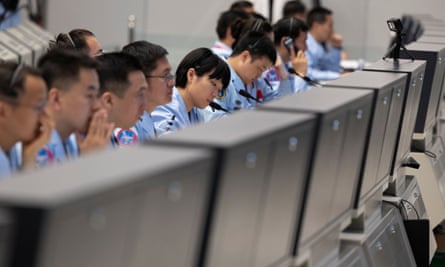China has landed its uncrewed Chang’e-6 lunar probe on the far side of the moon, marking an important step in the country’s 53-day mission to retrieve rock and soil samples from the “dark” lunar hemisphere, in what would be a world first.
The landing elevates China’s space power status in a global rush to the moon, where countries including the US are hoping to exploit lunar minerals to sustain long-term astronaut missions and moon bases within the next decade.
Prof Martin Barstow of the University of Leicester said the feat was a great technical success for the Chinese space programme. “Landing on the moon is difficult, but doing so on the far side, where communications are particularly difficult, is an enormous technical achievement,” said Barstow, a former president of the Royal Astronomical Society.
“We are not able to communicate with the far side directly from Earth, so other spacecraft need to be in orbit around the moon to relay commands and receive data,” he added.
The Chang’e-6 probe is expected to collect about 2kg of rock and soil samples from a region within one of the oldest craters on the moon, known as the South Pole-Aitken (SPA) basin. Then it must attempt an unprecedented launch from the far side of the moon.
The far side of the moon – sometimes called the “dark side” because it is not visible from Earth – is of considerable interest to scientists.
Prof Mahesh Anand, of the Open University, said: “Scientific analyses of these returned lunar samples using modern analytical methods and techniques could reveal new insights into the formation and evolution of the moon and by extension that of the solar system itself.”
Prof Neil Bowles from the University of Oxford agreed. “The South Pole-Aitken basin is an enormous impact structure on the far-side moon so it will have possibly excavated material from depths within the lunar crust,” he said.
“This means the new samples could have preserved details of the chemistry and history for a region of the moon’s sub-surface we haven’t had access to before. This will then tell us information on how the surface of the moon formed and may be about the impactor that formed the South Pole-Aitken basin.”
The Xinhua news agency said the retrieval of the samples should be complete within two days and would involve grabbing specimens using a robotic arm and drilling beneath the surface.
Barstow said the probe was tremendously important scientifically.
“We have never obtained samples from the far side before. It is a region with a terrain that is more mountainous and rockier than the side facing us and does not have the ‘seas’, which are flows of volcanic material and which have provided most lunar material so far. A successful return of these samples is certain to reveal exciting findings on the history of the moon and give insight into how it was formed.”
Prof Katherine Joy of the University of Manchester said access to rock samples from the far side of the moon was an “incredible” prospect.
“They have the potential to solve many of the scientific mysteries of why the near and far side of the moon are so different,” she said. “This knowledge will be a huge step forward for lunar and planetary science.”

While the space race has, historically, been dominated by the US and Russia, China and other countries, such as Japan and India, have been developing their own space programmes – including lunar missions.
It is not only probes that are en route to the moon: the US is planning a crewed mission by 2026, with China aiming to launch one by 2030. The latter is also planning to create an inhabited lunar base.
Washington has warned that Beijing’s space programme is being used to mask military objectives and an effort to establish dominance in space.
Dr Simeon Barber of the Open University said the samples collected by the Chang’e-6 probe could offer insights into our own origins.
“Ever since its formation, the moon has accompanied our planet, accumulating a record over time of particles – from the sub-atomically small to the devastatingly large – incoming from space,” he said.
“The return of these first samples from the far side provides entirely new pieces in the jigsaw to help us decipher the shared history of the moon and Earth, and the conditions through which our planet evolved and came to sustain life.”
Source: theguardian.com


